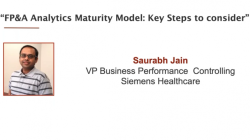High uncertainty was the other name for 2020, and FP&A's have been going through massive challenges and transformations to adjust to the New Normal. What are the top 10 Financial Planning and Analysis trends to watch in 2021 and beyond?
In his 26-minute presentation, Paul Ashley Head of Applications, Lloyds Development Capital Limited, explained how the company has successfully implemented a digitised approach to business partnering, financial forecasting, and the private equity valuation process.
Computer simulations allow us to play out various scenarios repeatedly and assess the outcomes. It is also true for computer simulations that are used in finance. Through scenario analysis, we can gain some comfort and assurance that the decision taken is the right one given the circumstances. However, there are a few considerations with the use of artificial intelligence (AI).
While automation has eliminated many repetitive tasks, the next step for FP&A is to develop advanced analytics capabilities.
On 17 November 2020, FP&A Trends Group gathered senior FP&A professionals from Electrolux, Jedox, Michael Page, Business Partnering Institute, and FP&A Trends Group who shared their insights on the five facets of the “New Normal” FP&A.
To manage business complexity, we need to focus on improving our processes. In this video, Saurabh Jain, explains how analytical journeys at different organisations usually look like.
Pagination
Subscribe to
FP&A Trends Digest

We will regularly update you on the latest trends and developments in FP&A. Take the opportunity to have articles written by finance thought leaders delivered directly to your inbox; watch compelling webinars; connect with like-minded professionals; and become a part of our global community.






